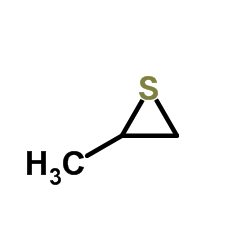2-Methylthiirane

2-Methylthiirane structure
|
Common Name | 2-Methylthiirane | ||
|---|---|---|---|---|
| CAS Number | 1072-43-1 | Molecular Weight | 74.145 | |
| Density | 1.0±0.1 g/cm3 | Boiling Point | 75.9±8.0 °C at 760 mmHg | |
| Molecular Formula | C3H6S | Melting Point | N/A | |
| MSDS | Chinese USA | Flash Point | 10.0±0.0 °C | |
| Symbol |


GHS02, GHS06 |
Signal Word | Danger | |
|
Enhanced tumor-targeted gene delivery by bioreducible polyethylenimine tethering EGFR divalent ligands.
Biomater. Sci. 3 , 1096-104, (2015) This work demonstrates successful delivery of a gene to EGFR-overexpressed cancer cells by using a rationally designed branched GE11 peptide as a targeting ligand. In addition, we exploited the effect of the divalent structure of the branched GE11 peptide on ... |
|
|
S-Nitrosated Polypropylene Sulfide Nanoparticles for Thiol-Dependent Transnitrosation and Toxicity Against Adult Female Filarial Worms.
Adv. Healthc. Mater. 4(10) , 1484-90, 1423, (2015) A synthetic polymer nanoparticle formulation utilizing the physiological nitrosothiol chemistry for nitric oxide delivery is shown. Toxicity of S-nitroso nanoparticles against adult female Brugia malayi worms, which are responsible for lymphatic filariasis, i... |
|
|
Preparing a pseudo-solid by the reinforcement of a polydentate thioether using silver nanoparticles.
Nanoscale 7(5) , 1977-83, (2015) The design of networks from polymers and noble metal nanoparticles requires thorough control over topological polymer-particle arrangements. This study explores the interaction between a linear polydentate poly(propylene sulfide) (PPrS) ligand and silver nano... |
|
|
Bioreducible guanidinylated polyethylenimine for efficient gene delivery.
ChemMedChem 9(12) , 2718-24, (2014) Cationic polymers are known to afford efficient gene transfection. However, cytotoxicity remains a problem at the molecular weight for optimal DNA delivery. As such, optimized polymeric gene delivery systems are still a sought-after research goal. A guanidiny... |
|
|
Chemisorbed poly(propylene sulphide)-based copolymers resist biomolecular interactions.
Nat. Mater. 2(4) , 259-64, (2003) Alkanethiolates have been widely used as chemisorbates to modify gold surfaces, in spite of their relatively poor oxidative stability. We introduce gold-chemisorbing block copolymers bearing an anchoring block of poly(propylene sulphide) (PPS), selected in th... |
|
|
Reduction-sensitive tioguanine prodrug micelles.
Mol. Pharm. 9(10) , 2812-8, (2012) Colloidal drug and prodrug conjugates have unique targeting characteristics for tumor vasculature from the blood and for the lymphatics draining a tissue injection site. Tioguanine and tioguanine-generating prodrugs have been investigated as anticancer and im... |
|
|
Diffusion NMR spectroscopy for the characterization of the size and interactions of colloidal matter: the case of vesicles and nanoparticles.
J. Am. Chem. Soc. 126(7) , 2142-7, (2004) We report the application of the pulse gradient spin-echo (PGSE) NMR technique (PGSE NMR) to the analysis of large colloidal materials, specifically vesicles formed from macromolecular amphiphiles and nanoparticles. Measurements of size and size distribution ... |
|
|
The chiroptical signature of achiral metal clusters induced by dissymmetric adsorbates.
Phys. Chem. Chem. Phys. 8(1) , 63-7, (2006) Using a dissymmetrically-perturbed particle-in-a-box model, we demonstrate that the induced optical activity of chiral monolayer protected clusters, such as Whetten's Au28(SG)16 glutathione-passivated gold nanoclusters (J. Phys. Chem. B, 2000, 104, 2630-2641)... |
|
|
Combination of episulfide ring-opening polymerization with ATRP for the preparation of amphiphilic block copolymers.
Macromol. Rapid Commun. 34(2) , 156-62, (2013) We report for the first time the combination of ATRP and ring-opening episulfide polymerization as a means to synthesize polysulfide-based low-dispersity amphiphilic block copolymers. The most significant finding is the possibility to perform ATRP under mild ... |
|
|
Constellational diastereomers in encapsulation complexes.
Chem. Commun. (Camb.) (15) , 1690-1, (2004) Three chiral guests in a cylindrical capsule led to six diastereomeric complexes. |